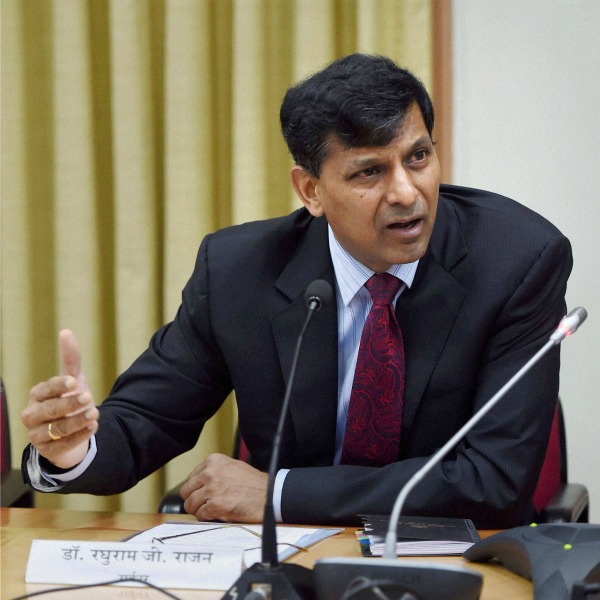Why RBI easing is ineffective and interest rates are still high
Wednesday, 24 June 2015 - 1:40pm IST | Place: Mumbai
Despite the sharp policy rate reduction during the first six months of 2015, the effect hasn’t trickled down to domestic interest rates significantly – the average reduction in interest rates is still at 0.25 – 0.30%.
 Raghuram Rajan, Governor, RBI during the second bi-monthly monetary policy announcement at RBI headquarters in Mumbai PTI
Raghuram Rajan, Governor, RBI during the second bi-monthly monetary policy announcement at RBI headquarters in Mumbai PTI
The Reserve Bank of India started its easing policy nearly two years back; then took a long break when it shifted focus from WPI to CPI, and restarted the cycle in the beginning of 2015. Since then, it has slashed policy interest rates thrice, by a cumulative 75 basis points or 0.75%. Despite the sharp policy rate reduction during the first six months of 2015, the effect hasn’t trickled down to domestic interest rates significantly – the average reduction in interest rates is still at 0.25 – 0.30%.
Banks have listed a number of reasons for not reducing the lending rates; however, here are some actual reasons.
BANKS ARE OLIGOPOLISTIC - The banking industry operates like an oligopoly in India, which means that most of the banks look towards the largest banks to see whether they have cut interest rates after the RBI policy, and then suit. This is despite the fact that there are a large number of public sector as well as private sector banks in India.
In spite of a sharp reduction in credit growth and high Net Interest Margins (difference between cost of funds and average lending rates), most banks have refused to follow the central bank’s cues of cutting rates. After significant prodding by the RBI governor, banks reluctantly passed on just about 30-40% of the total rate cut.
Over the last one or two years, PSU banks have also become extremely wary of lending due to rising Non-Performing Assets (NPAs). This, however, has improved the rent-seeking ability of private sector banks, where the Net Interest Margins have increased steadily. Most banks have different cost of funds and different business models but the lending rates are always similar.
HUGE NON-PERFORMING LOANS – Rising NPAs and restructured loans also reduce the ability of banks to cut interest rates. This is because, there’s a large proportion of the loan book which is neither fetching them any interest nor are they getting the principal amount back. On one hand, at a time when NPAs are increasing, there are a huge number of loans where the interest receipts are still being accounted for but not received by banks. Restructured loans also carry provisions that defer the principal amount or interest payments. On the other hand, banks still need to pay the interest on their deposits on time. This continuously creates a gap in cash receipts and payouts, and hence, reduces the ability of banks to cut interest rates. However, when the economy recovers and there is a reduction in NPAs, we might see sharper interest rate cuts.
RBI HAS BEEN A RELUCTANT EASER- The RBI may have cut policy rates, however, it hasn’t created a scenario of excess liquidity in the system. This is easy for the RBI to do, even without cutting the Cash Reserve Ratio (CRR).
1. RBI could have increased the Repo borrowing window which would have a direct impact on the lower rate lending abilities of several banks, as the Repo rate has been reduced by 0.75%, and there is substantial excess government bond holding with banks.
2. If RBI actually wants to push rates down, it could easily undertake Open Market Operations (OMOs) to buy government bonds from banks, and release liquidity into the economy. This would have an immediate impact on reducing the lending rates.
3. The Indian Rupee has become extremely uncompetitive as compared to most peer group emerging-market currencies. RBI has been a bystander in the entire process, and although it bought dollars from the markets, it wasn’t to its full extent. If done correctly, this could have had two impacts. First, the rupee would have been weaker than it is today, and provided a booster to exports and import substitution. The reserves which stand at $354 billion currently could have easily been closer to $400 billion. And second, it would have released rupee liquidity of Rs 1,50,000 crore into the system and brought interest rates down substantially from where they stand today.
The reasons for high interest rates are not what the banks would like us to believe. The blame lies with both, the banks and RBI. There is need for better lending practices as well as an oversight over oligopolistic tendencies. RBI also needs to come out straight about the several measures it can take to bring rates down.
As the Chief Economic Adviser, Arvind Subramanian recently said, India has one of the highest real rates in the world today as WPI, the benchmark on which rates were set up to two years back, stands at -2.5%, and average bank lending rates are still upwards of 11-12%.
Sandip Sabharwal is a fund manager who runs an investment advisory company. He can be reached at his website.

No comments:
Post a Comment